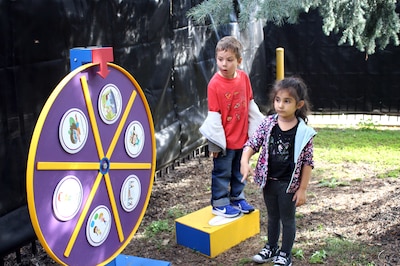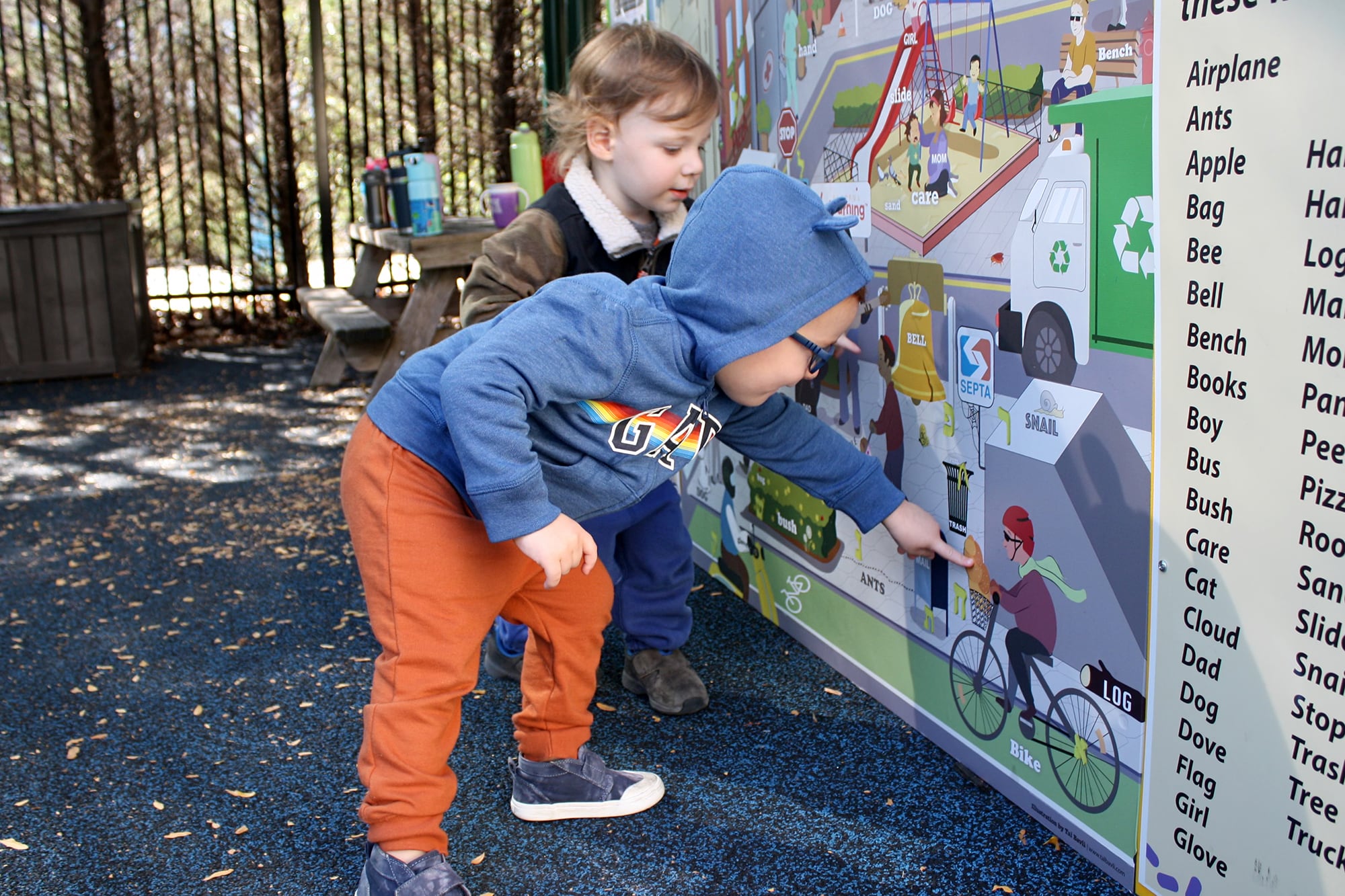Children at six Bright Horizons child care centers in the Philadelphia area have some new playground equipment: Interactive stations designed to promote learning while having fun.
Temple University researchers aim to measure how the “playful learning stations,” all designed with input from staff and community members, help the preschoolers learn skills like communication and pattern recognition.
It’s part of a plan to incorporate learning into non-classroom areas like playgrounds and even public spaces like bus stops and sidewalks, Temple psychology professor Kathy Hirsh-Pasek said.
Hirsh-Pasek’s theory is that children learn better when they’re having fun, and teachers enjoy teaching more when they design and teach activities designed to encourage playful learning. Experts have long said that play is essential to children’s healthy development.
The idea is “taking the science of learning and building it into the architecture of the built space,” said Hirsh-Pasek. It’s a technique being used at libraries — the Cecil B. Moore Library worked with members of its local North Philadelphia community on a “playbrary” that includes a spelling-based climbing wall — as well as bus stops and other facilities in Philadelphia and cities across the country, she said.
These “learning landscapes” have been shown to encourage learning, Hirsh-Pasek said. The library project, she said, encouraged more people to get library cards.
The Bright Horizons study is the first to test the concept in a school environment, said Hirsh-Pasek.
Interactive learning through play can also help combat learning loss from interruptions such as summer breaks and the more extended pandemic disruption, Hirsh-Paskek said. Temple research, for example, found that Playstreets, a Philadelphia program that closes designated streets to traffic during summer days and brings in learning games, resulted in better language skills.
Three of the six Bright Horizons centers are using stations geared toward literacy and language, and the other three are focused on science, technology, engineering, and math (commonly known as STEM). Some 100 children across the centers are participating, Hirsh-Pasek said.
Bright Horizons’ Buerger Early Learning Center at Congregation Rodeph Shalom has two installations fostering literacy and communications skills.
Temple researchers worked with Bright Horizon staff and parents to design an interactive mural with Philadelphia and community landmarks and characters that can be used for storytelling or recognition games. There’s also a “story wheel” with stations kids can spin to pick a character, a setting, a conflict, and a resolution, followed by a platform for presenting the narrative.
Since Buerger has a large Jewish constituency, the mural and story wheel feature characters and places relevant to Jewish life and culture. “It was really important for our mural to include Judaism, because we’re at the synagogue,” said Leah Briggin, Buerger’s director.
Installations at other Bright Horizons centers, which were all designed with parent and teacher input, have features central to their communities.
STEM activities include a dance game designed to encourage pattern and shape recognition.
In all cases, the idea is for kids to learn how to work together and communicate while developing critical thinking skills and self-confidence, Hirsh-Pasek said.
Bright Horizons, which operates year-round, set up the “playful learning” installations in June. The Temple study runs for this academic year, after which researchers will evaluate any changes in kids’ behavior or skills. “We’ll go back and see whether the students in the more STEM-based [centers] learn more STEM,” using tests given at the beginning and end of the project, and evaluating skills in areas including narrative, critical thinking, communications, and confidence for the kids using the language-based stations, Hirsh-Pasek said.

Temple received a grant for the program from the William Penn Foundation. Bright Horizons didn’t receive any direct funding, said Rachel Robertson, vice president of education and development at Bright Horizons. (Chalkbeat receives funding from the William Penn Foundation.)
Temple currently owns the installations, but Bright Horizons plans to consider how to bring the concept to other programs once the study ends, she said.
Preschool seems like the obvious place for playful learning. But the idea works just as well in higher grades and even in college, said Hirsh-Pasek, who uses “joyful learning” in her classes. “When it’s meaningful and it’s fun, you’re actually learning,” she said.
Teachers are also happy when they’re free to create fun activities to encourage learning, Hirsh-Pasek said.
“We all know that early childhood educators need and deserve more respect than they get,” Robertson said. Giving them a say in how to teach is one way of honoring that, she said.
Students gravitate to hands-on, interactive learning
The Bright Horizons venture isn’t the only real-world study of playful learning. Hirsh-Pasek said her team is embarking on a $20 million, four-state study to see how classrooms adapt to the approach. Teachers will work with small groups and hands-on projects, all developed with teacher input.
The idea has been shown to work, Hirsh-Pasek said. She cited examples in which a first grade teacher had a class jump on a number line on the floor to learn addition, and a basketball game designed to help fourth- to sixth-graders understand fractions and decimal conversion.
“Playful learning is the ideal,” Robertson said. “It really is how children learn best.” Kids “have to play with things, to get their hands on things, to experiment,” she said. “Playful learning allows them to try out the concepts they’re learning in real life.”
Bright Horizons teachers are already encouraged to foster kids’ curiosity, Robertson said. She recalled a teacher whose class was distracted by a group of birds at the window. Instead of drawing their focus back to the lesson she was teaching, “the teacher went with it,” letting the kids ask questions about birds and look up the answers, and ultimately building bird feeders based on what they learned, said Robertson.
Bright Horizons teachers at the centers participating in the project attended five training sessions before the program began, Robertson said. “Ensuring we can show the link between playful learning and learning outcomes is an important part of this,” she said.
Briggin said kids at her center use the mural both on their own and in teacher-guided activities. “We see a lot of children gravitating towards the mural,” she said. “They’re really interested in spotting things” they see on their way to school, or if one has made a weekend trip to a landmark they’ve seen on the mural they’ll want to point it out, she said.
Hirsh-Pasek said the “playful learning” installations at the Bright Horizon centers are popular with children. “It’s been amazing to watch,” she said. “It blows my mind at how easy, how cheap, and how effective this stuff is.”







